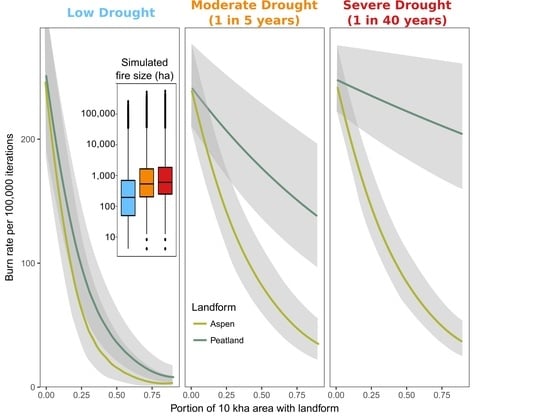Peatland Hydrological Dynamics as A Driver of Landscape Connectivity and Fire Activity in the Boreal Plain of Canada
Abstract
1. Introduction
2. Materials and Methods
2.1. Study Area
2.2. Mapping Flammable Vegetation
2.3. Dynamic Wetland Drying
2.4. Hydrologically Dynamic Fuel Type Assignments
2.5. Burn Probability Simulations
3. Results
3.1. Water Table Prediction
3.2. Fuel Distributions under Varying Drought Conditions
3.3. Wetland Fuels Iimpacts on Burn Probability
4. Discussion
5. Conclusions
Supplementary Materials
Author Contributions
Funding
Acknowledgments
Conflicts of Interest
Appendix A
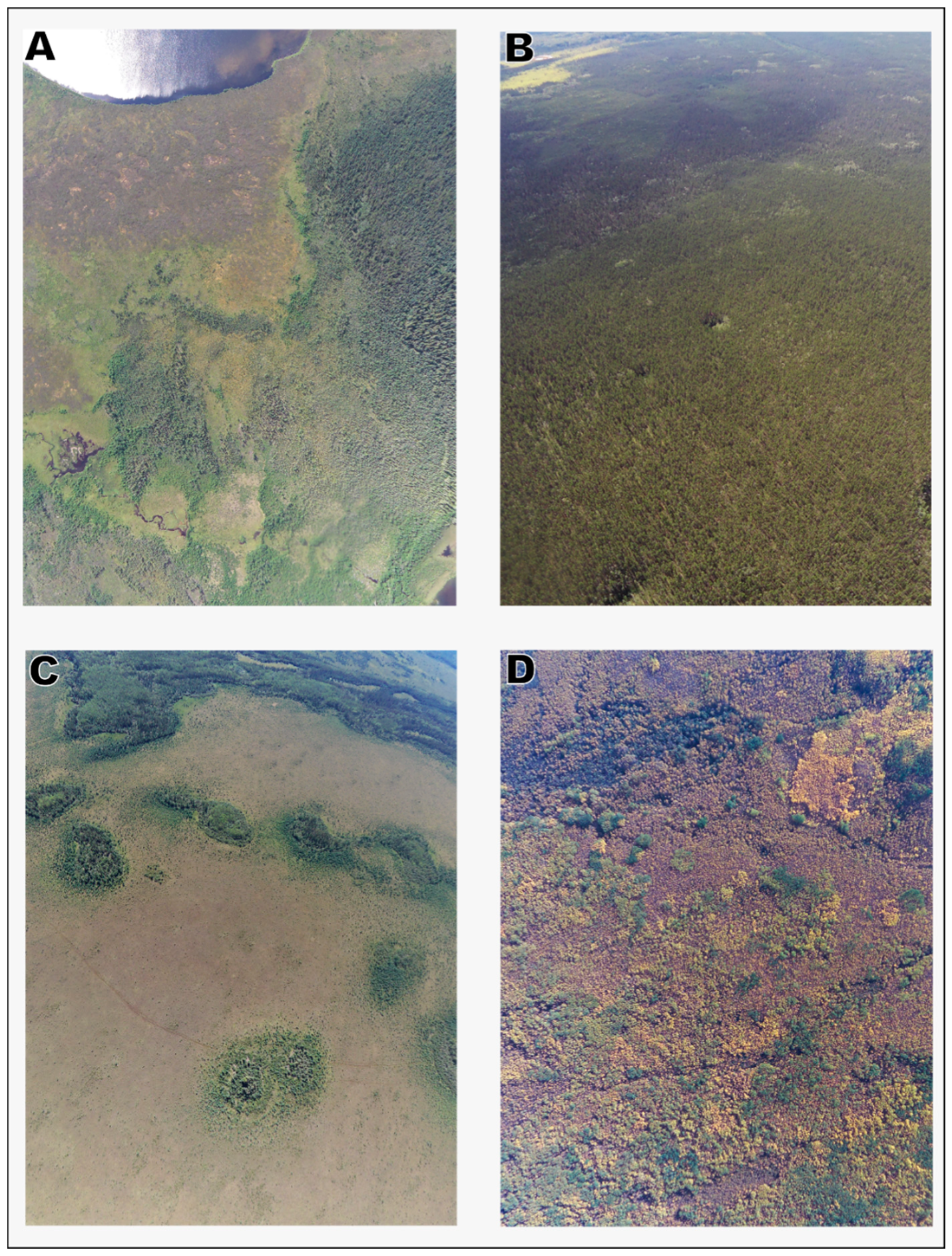
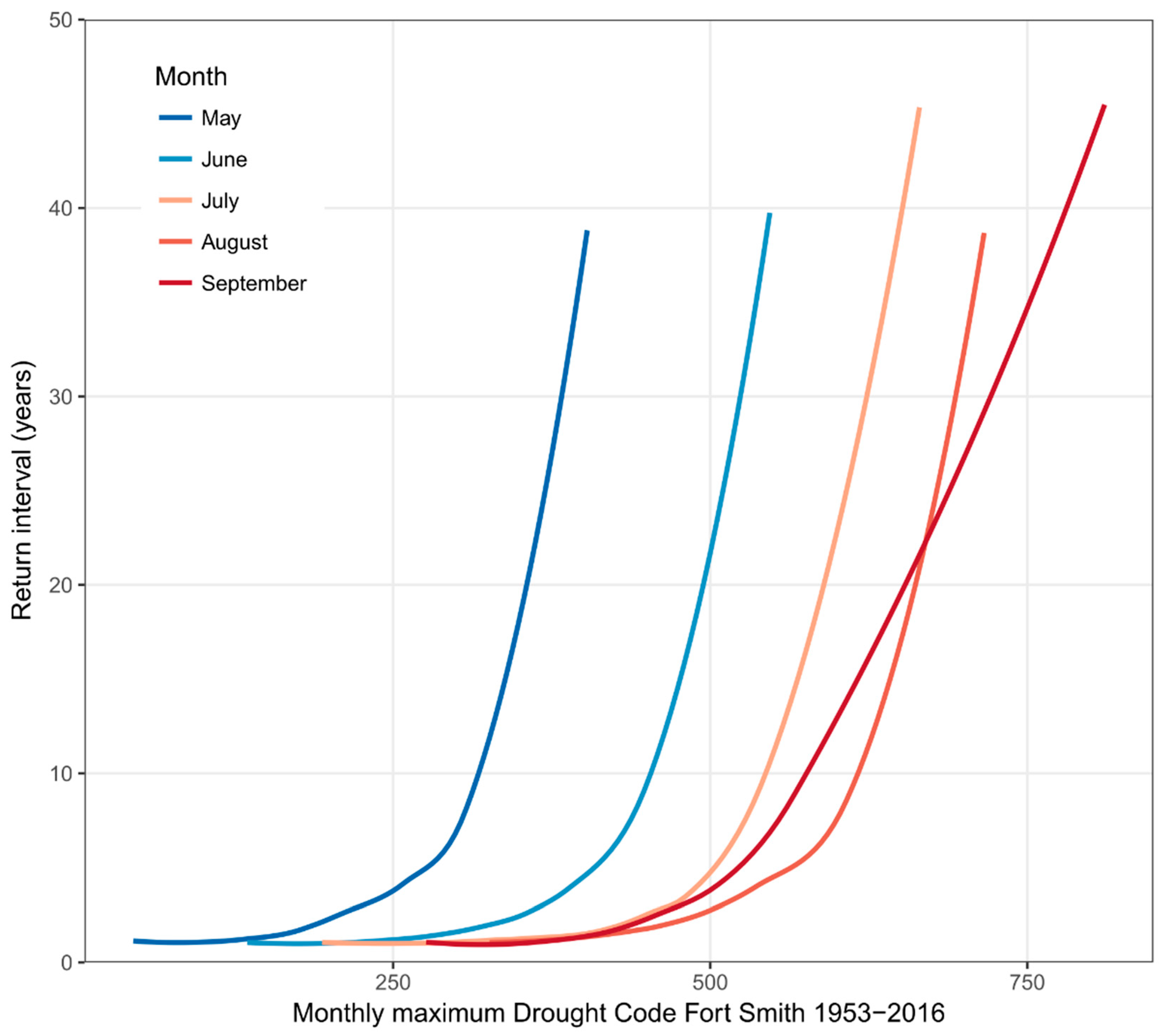
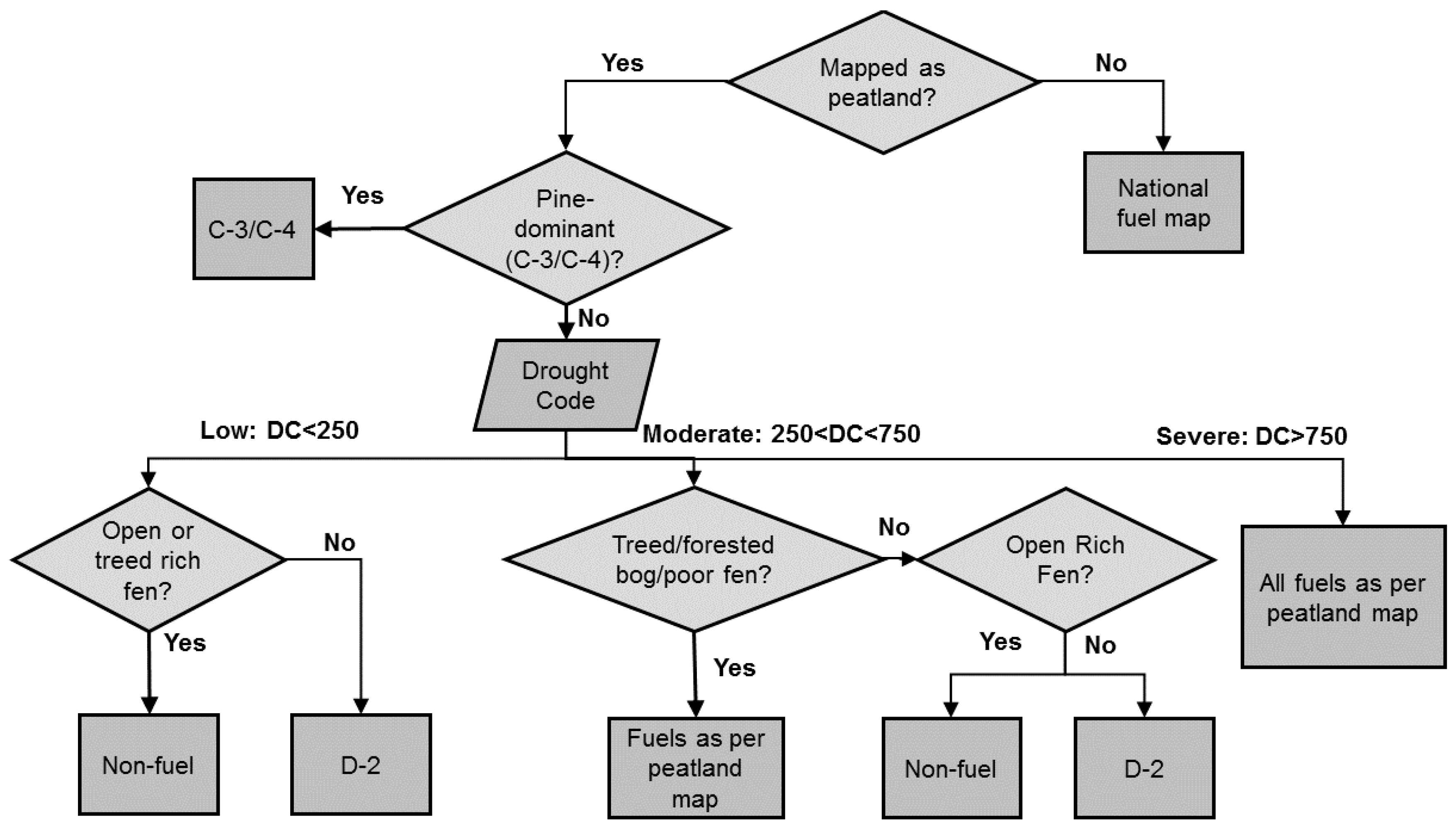
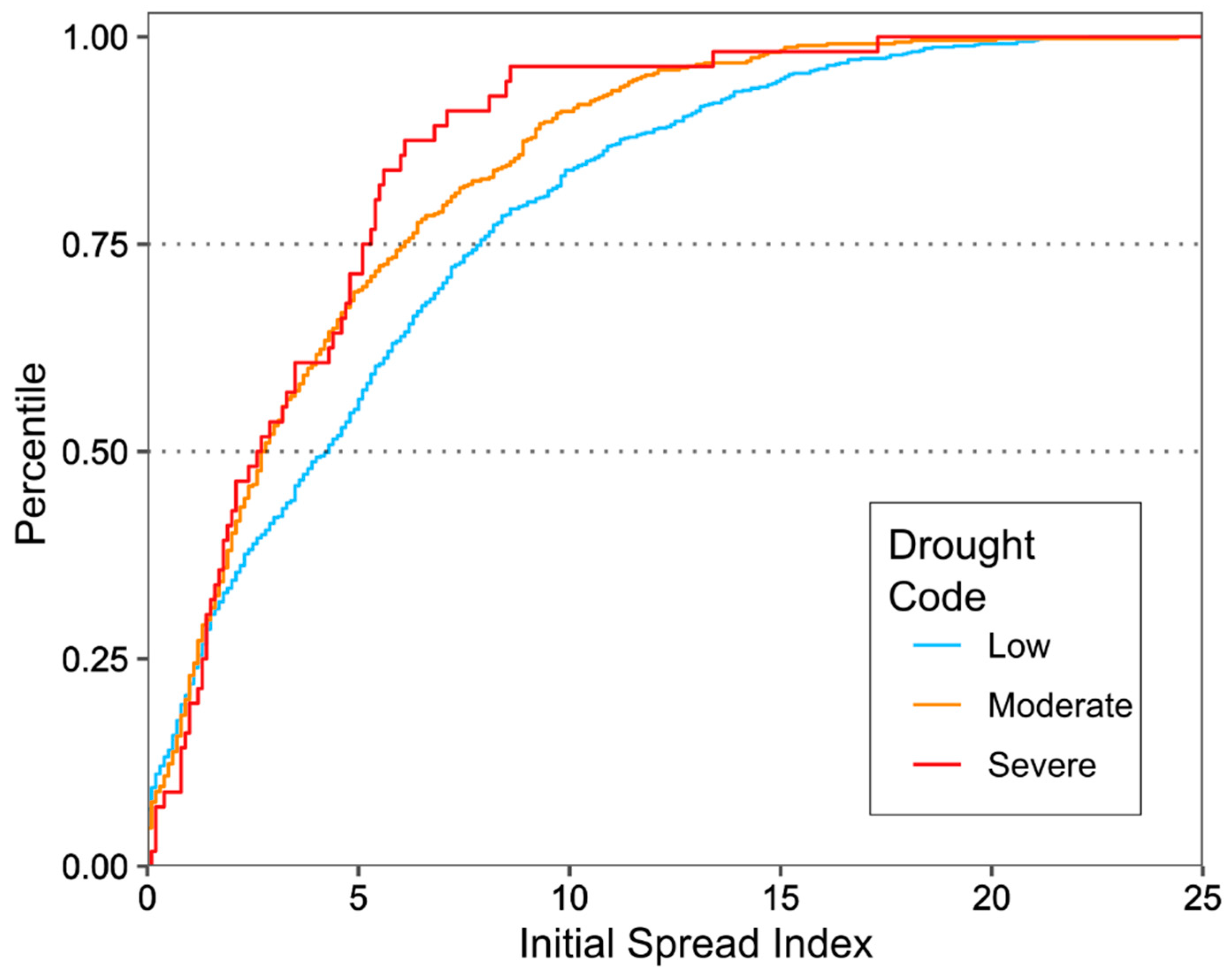
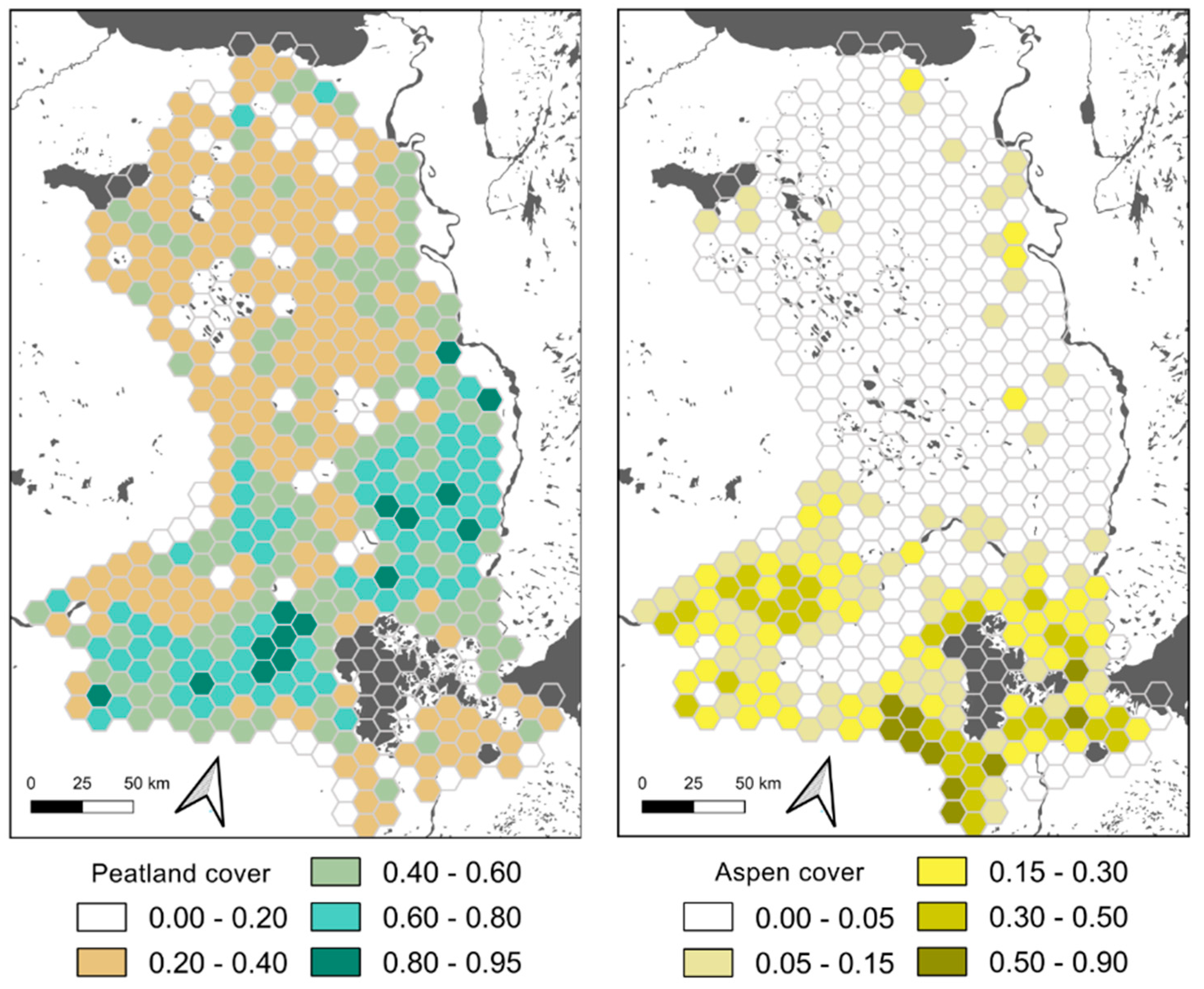
| Type | Tree Cover | Larix laricina% | Water Table (cm) | ||
|---|---|---|---|---|---|
| DC 250 | DC 500 | DC 750 | |||
| Open bog | < 10% | <25% | -23 | -34 | -46 |
| Treed bog | 10–25% | <25% | −37 | −48 | −59 |
| Forested bog | >25% | <25% | −40 | −52 | −63 |
| Open poor fen | <10% | 25–50% | −10 | −21 | −32 |
| Treed poor fen | 10–25% | 25–50% | −24 | −35 | −46 |
| Forested poor fen | >25% | 25–50% | −27 | −38 | −49 |
| Open rich fen | <10% | >50% | −5 | −16 | −26 |
| Treed rich fen | 10–25% | >50% | −19 | −29 | −39 |
| Forested poor fen | >25% | >50% | −22 | −32 | −43 |
| Coefficient | Estimate | Std Error | t Value | p |
|---|---|---|---|---|
| Intercept | −28.4 | 4.4 | −6.4 | <0.001 |
| Open | 16.6 | 2.0 | 8.1 | <0.001 |
| Treed | 3.2 | 2 | 1.6 | 0.10 |
| Poor fen | 12.5 | 7.2 | 1.8 | 0.086 |
| Rich fen | 16.8 | 5.4 | 3.1 | 0.0019 |
| Bog:DC | −0.046 | 0.015 | −2.9 | 0.003 |
| Poor fen:DC | −0.044 | 0.023 | −1.8 | 0.064 |
| Rich fen:DC | −0.041 | 0.012 | −3.4 | <0.001 |
References
- Xu, J.; Morris, P.J.; Liu, J.; Holden, J. PEATMAP: Refining estimates of global peatland distribution based on a meta-analysis. CATENA 2018, 160, 134–140. [Google Scholar] [CrossRef]
- Wells, E.D.; Zoltai, S.C. The Canadian system of wetland classification and its application to circumboreal wetlands. Aquilo Ser Bot. 1985, 21, 45–52. [Google Scholar]
- Turetsky, M.R.; Amiro, B.D.; Bosch, E.; Bhatti, J.S. Historical burn area in western Canadian peatlands and its relationship to fire weather indices. Glob. Biogeochem. Cycles 2004, 18. [Google Scholar] [CrossRef]
- Benscoter, B.W.; Vitt, D.H. Spatial Patterns and Temporal Trajectories of the Bog Ground Layer along a Post-Fire Chronosequence. Ecosystems 2008, 11, 1054–1064. [Google Scholar] [CrossRef]
- Thompson, D.K.; Benscoter, B.W.; Waddington, J.M. Water balance of a burned and unburned forested boreal peatland. Hydrol. Process. 2014, 28, 5954–5964. [Google Scholar] [CrossRef]
- Schiks, T.J.; Wotton, B.M.; Turetsky, M.R.; Benscoter, B.W. Variation in fuel structure of boreal fens. Can. J. For. Res. 2016, 46, 683–695. [Google Scholar] [CrossRef]
- Thompson, D.K.; Parisien, M.-A.; Morin, J.; Millard, K.; Larsen, C.P.S.; Simpson, B.N. Fuel accumulation in a high-frequency boreal wildfire regime: from wetland to upland. Can. J. For. Res. 2017, 47, 957–964. [Google Scholar] [CrossRef]
- Turetsky, M.; Wieder, K.; Halsey, L.; Vitt, D. Current disturbance and the diminishing peatland carbon sink. Geophys. Res. Lett. 2002, 29, 21-1-21–4. [Google Scholar] [CrossRef]
- Boulanger, Y.; Gauthier, S.; Burton, P.J. A refinement of models projecting future Canadian fire regimes using homogeneous fire regime zones. Can. J. For. Res. 2014, 44, 365–376. [Google Scholar] [CrossRef]
- Devito, K.J.; Creed, I.F.; Fraser, C.J.D. Controls on runoff from a partially harvested aspen-forested headwater catchment, Boreal Plain, Canada. Hydrol. Process. 2005, 19, 3–25. [Google Scholar] [CrossRef]
- Wang, Y.; Hogg, E.H.; Price, D.T.; Edwards, J.; Williamson, T. Past and projected future changes in moisture conditions in the Canadian boreal forest. For. Chron. 2014, 90, 678–691. [Google Scholar] [CrossRef]
- Flannigan, M.D.; Wotton, B.M.; Marshall, G.A.; de Groot, W.J.; Johnston, J.; Jurko, N.; Cantin, A.S. Fuel moisture sensitivity to temperature and precipitation: climate change implications. Clim. Change 2016, 134, 59–71. [Google Scholar] [CrossRef]
- Wotton, B.M.; Stocks, B.J.; Martell, D.L. An index for tracking sheltered forest floor moisture within the Canadian Forest Fire Weather Index System. Int. J. Wildland Fire 2005, 14, 169–182. [Google Scholar] [CrossRef]
- Waddington, J.M.; Morris, P.J.; Kettridge, N.; Granath, G.; Thompson, D.K.; Moore, P.A. Hydrological feedbacks in northern peatlands. Ecohydrology 2015, 8, 113–127. [Google Scholar] [CrossRef]
- Whitman, E.; Parisien, M.-A.; Thompson, D.K.; Hall, R.J.; Skakun, R.S.; Flannigan, M.D. Variability and drivers of burn severity in the northwestern Canadian boreal forest. Ecosphere 2018, 9, e02128. [Google Scholar] [CrossRef]
- Waddington, J.M.; Thompson, D.K.; Wotton, M.; Quinton, W.L.; Flannigan, M.D.; Benscoter, B.W.; Baisley, S.A.; Turetsky, M.R. Examining the utility of the Canadian Forest Fire Weather Index System in boreal peatlands. Can. J. For. Res. 2011, 42, 47–58. [Google Scholar] [CrossRef]
- Finney, M.A. The challenge of quantitative risk analysis for wildland fire. For. Ecol. Manag. 2005, 211, 97–108. [Google Scholar] [CrossRef]
- Ferone, J.M.; Devito, K.J. Shallow groundwater–surface water interactions in pond–peatland complexes along a Boreal Plains topographic gradient. J. Hydrol. 2004, 292, 75–95. [Google Scholar] [CrossRef]
- Lemmen, D.S.; Duk-Rodkin, A.; Bednarski, J.M. Late glacial drainage systems along the northwestern margin of the Laurentide Ice Sheet. Quat. Sci. Rev. 1994, 13, 805–828. [Google Scholar] [CrossRef]
- Commission for Environmental Cooperation Ecological Regions of North America. Available online: http://www.cec.org/tools-and-resources/map-files/terrestrial-ecoregions-level-ii (accessed on 29 May 2019).
- Forestry Canada Fire Danger Rating Group. Development and structure of the Canadian Forest Fire Behavior Prediction System; Information Report; Forestry Canada, Headquarters, Fire Danger Group and Science and Sustainable Development Directorate: Ottawa, ON, Canada, 1992; Volume ST-X-3, ISBN 978-0-662-19812-3. [Google Scholar]
- Thompson, D.K.; Waddington, J.M. Wildfire effects on vadose zone hydrology in forested boreal peatland microforms. J. Hydrol. 2013, 486, 48–56. [Google Scholar] [CrossRef]
- Johnston, D.C.; Turetsky, M.R.; Benscoter, B.W.; Wotton, B.M. Fuel load, structure, and potential fire behaviour in black spruce bogs. Can. J. For. Res. 2015, 45, 888–899. [Google Scholar] [CrossRef]
- Whitman, E.; Parisien, M.-A.; Thompson, D.K.; Flannigan, M.D. Topoedaphic and Forest Controls on Post-Fire Vegetation Assemblies Are Modified by Fire History and Burn Severity in the Northwestern Canadian Boreal Forest. Forests 2018, 9, 151. [Google Scholar] [CrossRef]
- Webster, K.L.; Bhatti, J.S.; Thompson, D.K.; Nelson, S.A.; Shaw, C.H.; Bona, K.A.; Hayne, S.L.; Kurz, W.A. Spatially-integrated estimates of net ecosystem exchange and methane fluxes from Canadian peatlands. Carbon Balance Manag. 2018, 13, 16. [Google Scholar] [CrossRef]
- Thompson, D.K.; Simpson, B.N.; Beaudoin, A. Using forest structure to predict the distribution of treed boreal peatlands in Canada. For. Ecol. Manag. 2016, 372, 19–27. [Google Scholar] [CrossRef]
- Zoltai, S.C.; Siltanen, R.M.; Johnson, J.D. A wetland data base for the western boreal, subarctic, and arctic regions of Canada; Information Report; Canadian Forest Service, Northern Forestry Centre: Edmonton, AB, Canada, 2000; ISBN 978-0-662-28539-7.
- Beverly, J.L.; Wotton, B.M. Modelling the probability of sustained flaming: predictive value of fire weather index components compared with observations of site weather and fuel moisture conditions. Int. J. Wildland Fire 2007, 16, 161–173. [Google Scholar] [CrossRef]
- Price, J. Soil moisture, water tension, and water table relationships in a managed cutover bog. J. Hydrol. 1997, 202, 21–32. [Google Scholar] [CrossRef]
- Lafleur, P.M.; Hember, R.A.; Admiral, S.W.; Roulet, N.T. Annual and seasonal variability in evapotranspiration and water table at a shrub-covered bog in southern Ontario, Canada. Hydrol. Process. 2005, 19, 3533–3550. [Google Scholar] [CrossRef]
- Griffis, J.T. Inter-Annual Variability of Net Ecosystem Carbon Dioxide Exchange at a Subarctic Fen. Ph.D. Thesis, McMaster University, Hamilton, ON, Canada, 2000. [Google Scholar]
- Alexander, M.E. Surface fire spread potential in trembling aspen during summer in the Boreal Forest Region of Canada. For. Chron. 2010, 86, 200–212. [Google Scholar] [CrossRef]
- Tymstra, C.; Bryce, R.W.; Wotton, B.M.; Taylor, S.W.; Armitage, O.B. Development and structure of Prometheus: the Canadian Wildland Fire Growth Simulation Model.; Information Report; Natural Resources Canada, Canadian Forest Service, Northern Forestry Centre: Edmonton, AB, Canada, 2010; ISBN 978-1-100-14674-4.
- Parisien, M.-A.; Kafka, V.; Hirsch, K.G.; Todd, J.B.; Lavoie, S.G.; Maczek, P.D. Mapping Wildfire Susceptibility with the BURN-P3 Simulation Model; Natural Resources Canada, Canadian Forest Service, Northern Forestry Centre: Edmonton, AB, Canada, 2005; Volume 405.
- Parisien, M.-A.; Parks, S.A.; Miller, C.; Krawchuk, M.A.; Heathcott, M.; Moritz, M.A. Contributions of Ignitions, Fuels, and Weather to the Spatial Patterns of Burn Probability of a Boreal Landscape. Ecosystems 2011, 14, 1141–1155. [Google Scholar] [CrossRef]
- Parisien, M.-A.; Walker, G.R.; Little, J.M.; Simpson, B.N.; Wang, X.; Perrakis, D.D.B. Considerations for modeling burn probability across landscapes with steep environmental gradients: an example from the Columbia Mountains, Canada. Nat. Hazards 2013, 66, 439–462. [Google Scholar] [CrossRef]
- Parisien, M.-A.; Miller, C.; Ager, A.A.; Finney, M.A. Use of artificial landscapes to isolate controls on burn probability. Landsc. Ecol. 2010, 25, 79–93. [Google Scholar] [CrossRef]
- Elmes, M.C.; Thompson, D.K.; Sherwood, J.H.; Price, J.S. Hydrometeorological conditions preceding wildfire, and the subsequent burning of a fen watershed in Fort McMurray, Alberta, Canada. Nat. Hazards Earth Syst. Sci. 2018, 18, 157–170. [Google Scholar] [CrossRef]
- Abatzoglou, J.T.; Williams, A.P. Impact of anthropogenic climate change on wildfire across western US forests. Proc. Natl. Acad. Sci.USA 2016, 113, 11770–11775. [Google Scholar] [CrossRef] [PubMed]
- Hanes, C.C.; Wang, X.; Jain, P.; Parisien, M.-A.; Little, J.M.; Flannigan, M.D. Fire-regime changes in Canada over the last half century. Can. J. For. Res. 2018, 49, 256–269. [Google Scholar] [CrossRef]
- Veraverbeke, S.; Rogers, B.M.; Goulden, M.L.; Jandt, R.R.; Miller, C.E.; Wiggins, E.B.; Randerson, J.T. Lightning as a major driver of recent large fire years in North American boreal forests. Nat. Clim. Change 2017, 7, 529–534. [Google Scholar] [CrossRef]
- Wotton, B.M.; Nock, C.A.; Flannigan, M.D. Forest fire occurrence and climate change in Canada. Int. J. Wildland Fire 2010, 19, 253–271. [Google Scholar] [CrossRef]
- Page, S.E.; Siegert, F.; Rieley, J.O.; Boehm, H.-D.V.; Jaya, A.; Limin, S. The amount of carbon released from peat and forest fires in Indonesia during 1997. Nature 2002, 420, 61. [Google Scholar] [CrossRef] [PubMed]
- Yu, Z.C. Northern peatland carbon stocks and dynamics: a review. Biogeosciences 2012, 9, 4071–4085. [Google Scholar] [CrossRef]
- Loisel, J.; Yu, Z. Recent acceleration of carbon accumulation in a boreal peatland, south central Alaska. J. Geophys. Res. Biogeosciences 2013, 118, 41–53. [Google Scholar] [CrossRef]
- Magnan, G.; Lavoie, M.; Payette, S. Impact of fire on long-term vegetation dynamics of ombrotrophic peatlands in northwestern Québec, Canada. Quat. Res. 2012, 77, 110–121. [Google Scholar] [CrossRef]
- Busque, D.; Arseneault, D. Fire disturbance of larch woodlands in string fens in northern Québec. Can. J. Bot. 2005, 83, 599–609. [Google Scholar] [CrossRef]
- Turner, M.G.; Romme, W.H. Landscape dynamics in crown fire ecosystems. Landsc. Ecol. 1994, 9, 59–77. [Google Scholar] [CrossRef]
- Marchal, J.; Cumming, S.G.; McIntire, E.J.B. Exploiting Poisson additivity to predict fire frequency from maps of fire weather and land cover in boreal forests of Québec, Canada. Ecography 2017, 40, 200–209. [Google Scholar] [CrossRef]
- Benscoter, B.W.; Wieder, R.K. Variability in organic matter lost by combustion in a boreal bog during the 2001 Chisholm fire. Can. J. For. Res. 2003, 33, 2509–2513. [Google Scholar] [CrossRef]
- Flannigan, M.D.; Krawchuk, M.A.; de Groot, W.J.; Wotton, B.M.; Gowman, L.M. Implications of changing climate for global wildland fire. Int. J. Wildland Fire 2009, 18, 483–507. [Google Scholar] [CrossRef]
- Girardin, M.P.; Wotton, B.M. Summer Moisture and Wildfire Risks across Canada. J. Appl. Meteorol. Climatol. 2009, 48, 517–533. [Google Scholar] [CrossRef]
- Anderson, K. A model to predict lightning-caused fire occurrences. Int. J. Wildland Fire 2002, 11, 163–172. [Google Scholar] [CrossRef]
- Wotton, B.M.; Martell, D.L. A lightning fire occurrence model for Ontario. Can. J. For. Res. 2005, 35, 1389–1401. [Google Scholar] [CrossRef]
- Peters, D.P.C.; Pielke, R.A.; Bestelmeyer, B.T.; Allen, C.D.; Munson-McGee, S.; Havstad, K.M. Cross-scale interactions, nonlinearities, and forecasting catastrophic events. Proc. Natl. Acad. Sci. USA 2004, 101, 15130–15135. [Google Scholar] [CrossRef]
- Erni, S.; Arseneault, D.; Parisien, M.-A.; Bégin, Y. Spatial and temporal dimensions of fire activity in the fire-prone eastern Canadian taiga. Glob. Change Biol. 2017, 23, 1152–1166. [Google Scholar] [CrossRef]
- Parks, S.A.; Parisien, M.-A.; Miller, C.; Holsinger, L.M.; Baggett, L.S. Fine-scale spatial climate variation and drought mediate the likelihood of reburning. Ecol. Appl. 2018, 28, 573–586. [Google Scholar] [CrossRef] [PubMed]
- Dai, A. Increasing drought under global warming in observations and models. Nat. Clim. Change 2013, 3, 52–58. [Google Scholar] [CrossRef]
- Turetsky, M.R.; Baltzer, J.L.; Johnstone, J.F.; Mack, M.C.; McCann, K.; Schuur, E.A.G. Losing Legacies, Ecological Release, and Transient Responses: Key Challenges for the Future of Northern Ecosystem Science. Ecosystems 2017, 20, 23–30. [Google Scholar] [CrossRef]
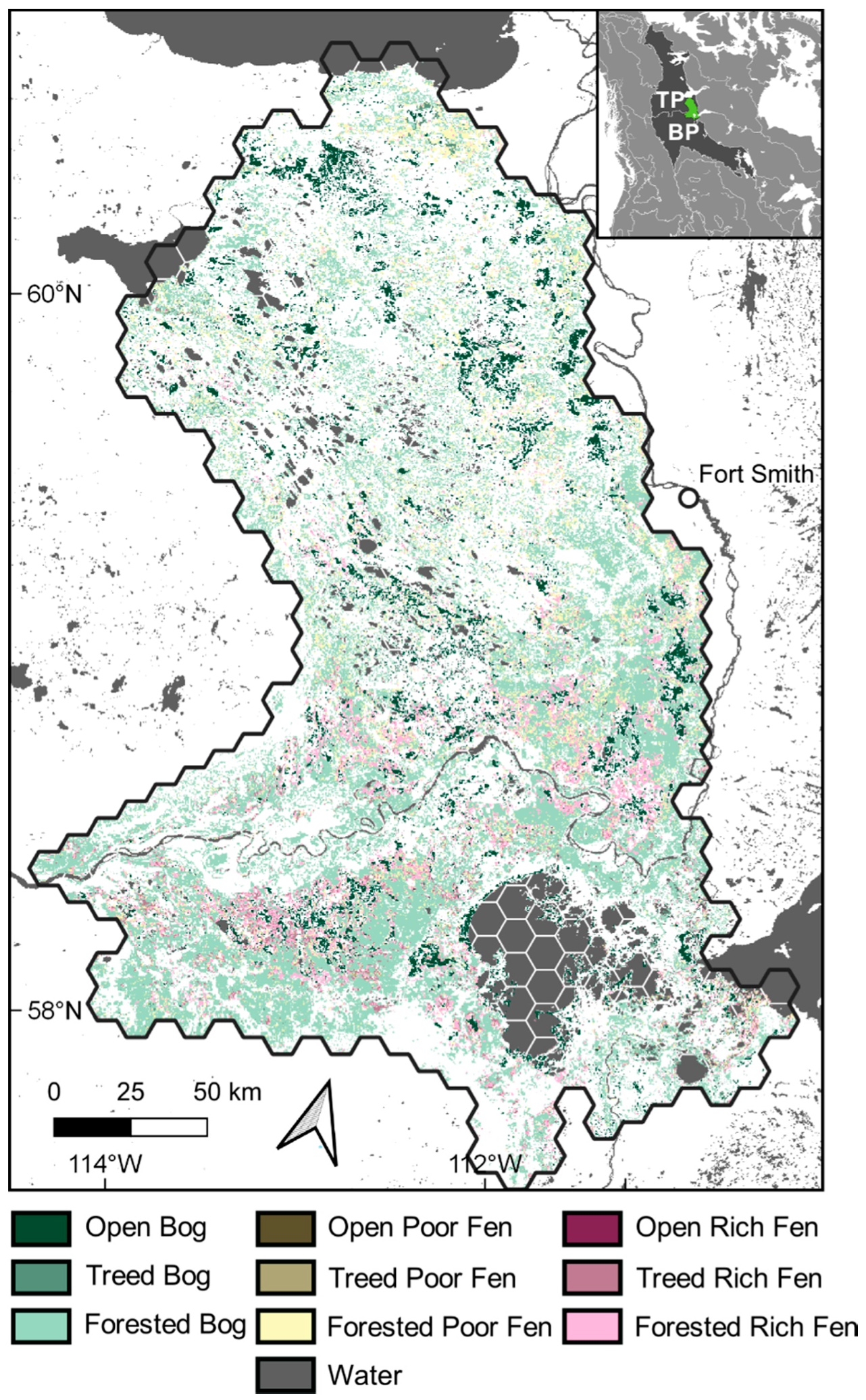
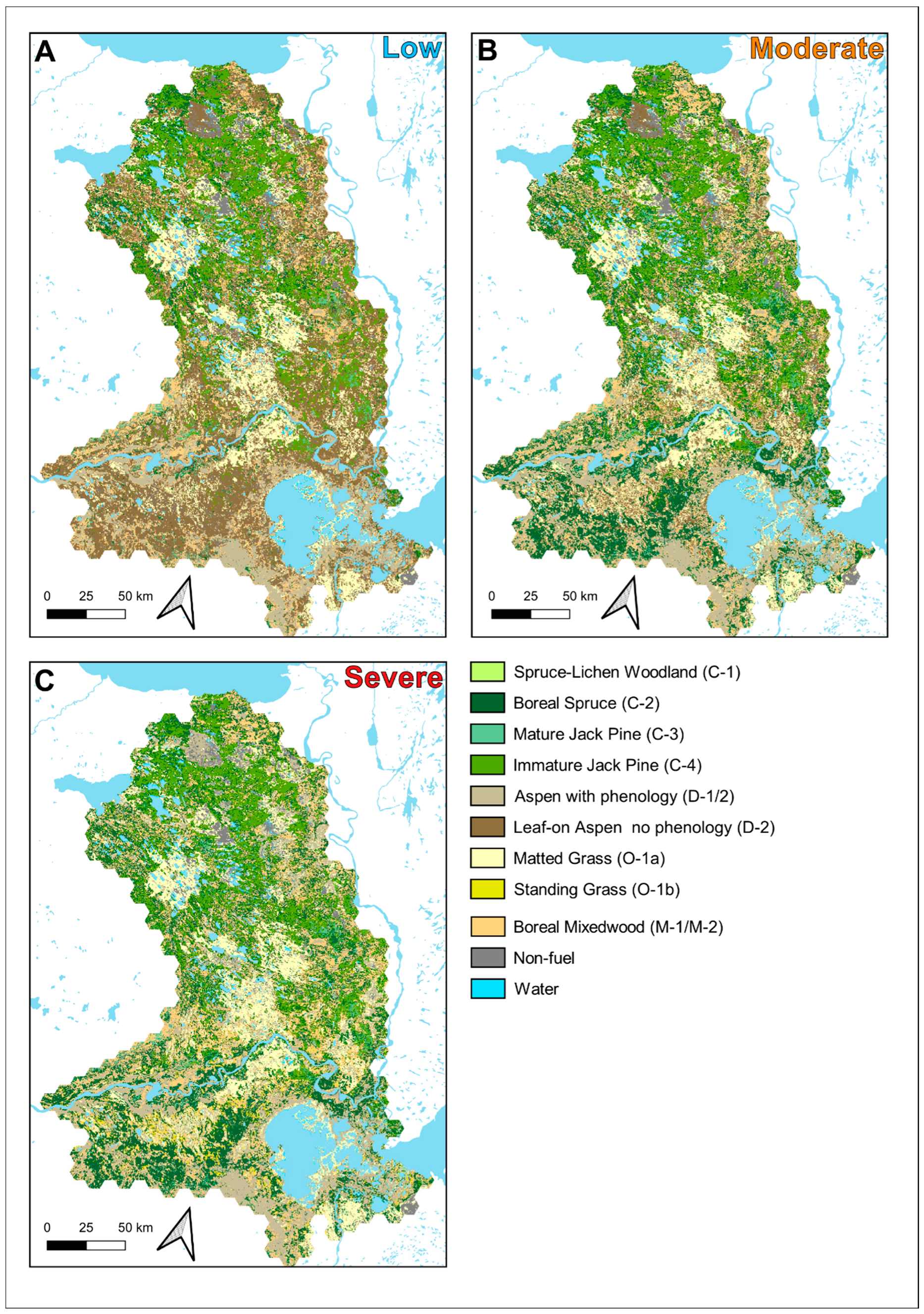
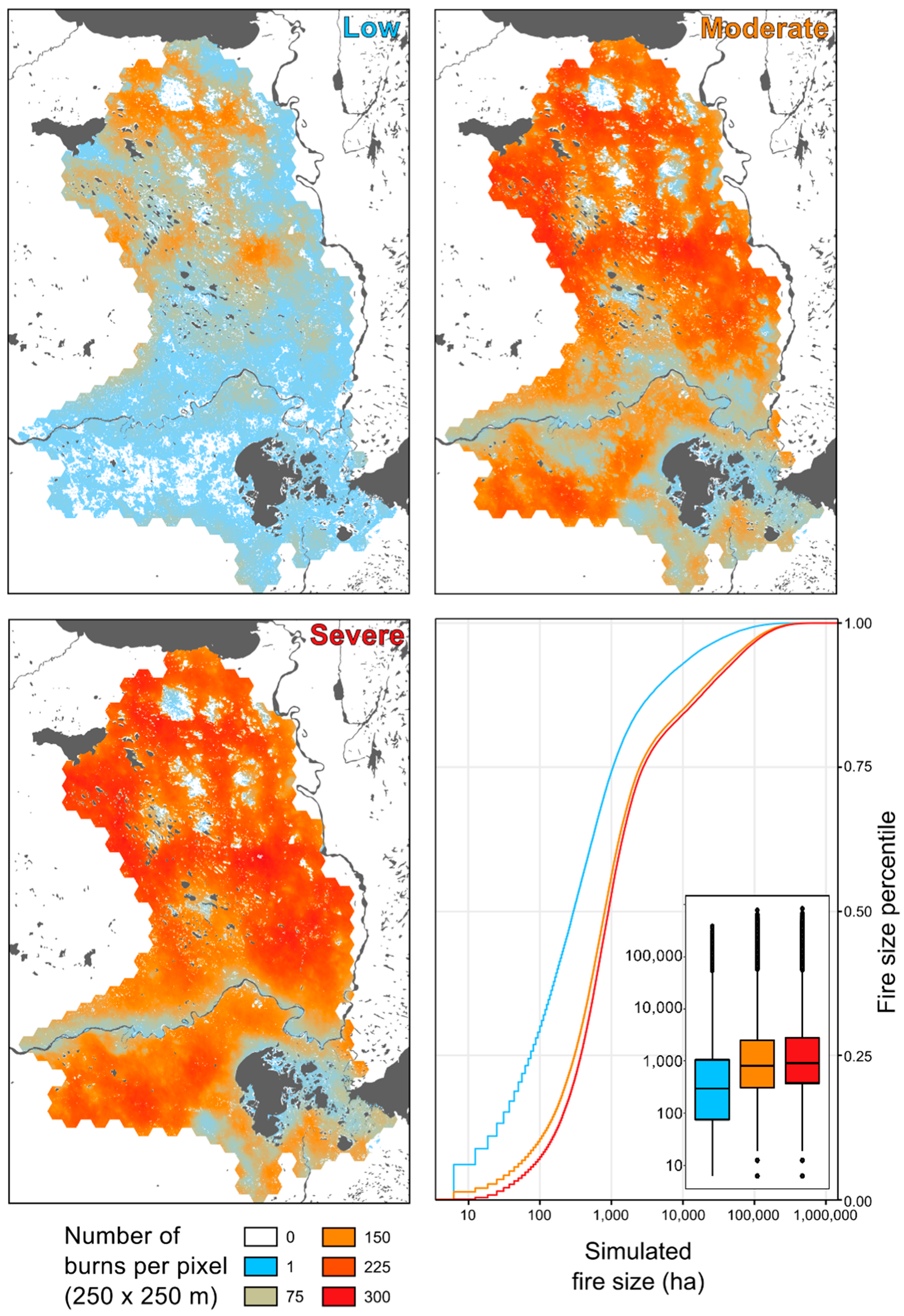

| Scenario | Bog | Poor Fen | Bog | Rich Fen | Poor Fen | Bog | Rich Fen | ||
|---|---|---|---|---|---|---|---|---|---|
| Forested | Treed | Treed | Treed | Forested | Open | Open | Forested | Open | |
| Low | D-2 | D-2 | D-2 | NF | D-2 | NF | D-2 | D-2 | NF |
| Moderate | C-2 | O-1a | M-1/2 C50 | O-1a | M-1/2 C80 | NF | D-2 | D-2 | NF |
| Severe | C-2 | O-1b | C-2 | O-1b | M-1/2 C80 | O-1b | D-1 | M-1/2 C65 | O-1b |
| % of study area | 22.5 | 0.1 | 0.8 | 1.1 | 4.1 | 0.0 | 5.0 | 3.6 | 0.0 |
| Critical DC | 250 | 290 | 330 | 400 | 560 | 600 | 640 | 670 | 710 |
| Fuel Type | Low | Moderate | Severe | Rate of Spread * |
|---|---|---|---|---|
| C-1 spruce-lichen woodland | 0.2 | 0.2 | 0.2 | 2 |
| C-2 boreal spruce | 8.1 | 25.2 | 25.9 | 10 |
| C-3 mature jack pine | 2.0 | 2.0 | 2.0 | 3 |
| C-4 immature jack pine | 12.3 | 12.3 | 12.3 | 11 |
| D-1 leafless aspen | 0.0 | 0.0 | 5.0 | 2 |
| D-2 green aspen | 30.7 | 8.7 | 0.0 | 0.4 |
| D-1/2 aspen with phenology ** | 8.0 | 8.0 | 8.0 | 0.4 |
| O-1a matted grass | 13.0 | 14.1 | 13.0 | 3 |
| O-1b standing grass | 0.0 | 0.0 | 1.2 | 7 |
| Non-fuel | 4.4 | 3.3 | 3.3 | 0 |
| Water | 9.9 | 9.9 | 9.9 | 0 |
| Mixedwood 50% conifer | 11.4 | 12.2 | 11.4 | 5.5 |
| Mixedwood 65% conifer | 0.0 | 0.0 | 3.6 | 7 |
| Mixedwood 80% conifer | 0.0 | 4.1 | 4.1 | 8.5 |
| Total open (O) | 13.0 | 14.1 | 14.2 | - |
| Total conifer (C) | 22.6 | 39.6 | 40.4 | - |
| Total mixedwood (M) | 11.4 | 16.2 | 19.2 | - |
| Total deciduous (D) | 38.7 | 16.7 | 13.1 | - |
| Total D-2 + non-fuel | 35.1 | 12.0 | 3.3 | - |
© 2019 by the authors. Licensee MDPI, Basel, Switzerland. This article is an open access article distributed under the terms and conditions of the Creative Commons Attribution (CC BY) license (http://creativecommons.org/licenses/by/4.0/).
Share and Cite
Thompson, D.K.; Simpson, B.N.; Whitman, E.; Barber, Q.E.; Parisien, M.-A. Peatland Hydrological Dynamics as A Driver of Landscape Connectivity and Fire Activity in the Boreal Plain of Canada. Forests 2019, 10, 534. https://doi.org/10.3390/f10070534
Thompson DK, Simpson BN, Whitman E, Barber QE, Parisien M-A. Peatland Hydrological Dynamics as A Driver of Landscape Connectivity and Fire Activity in the Boreal Plain of Canada. Forests. 2019; 10(7):534. https://doi.org/10.3390/f10070534
Chicago/Turabian StyleThompson, Dan K., Brian N. Simpson, Ellen Whitman, Quinn E. Barber, and Marc-André Parisien. 2019. "Peatland Hydrological Dynamics as A Driver of Landscape Connectivity and Fire Activity in the Boreal Plain of Canada" Forests 10, no. 7: 534. https://doi.org/10.3390/f10070534
APA StyleThompson, D. K., Simpson, B. N., Whitman, E., Barber, Q. E., & Parisien, M.-A. (2019). Peatland Hydrological Dynamics as A Driver of Landscape Connectivity and Fire Activity in the Boreal Plain of Canada. Forests, 10(7), 534. https://doi.org/10.3390/f10070534





